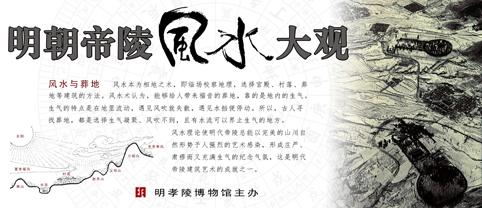Photo Exhibition of "Overview of Feng Shui (Geomancy) of Imperial Tombs of the Ming Dynasty" Reveals the Importance of Feng Shui in Selecting Imperial Burial Sites


Photo Exhibition of "Overview of Feng Shui of Imperial Tombs of the Ming Dynasty", one of the serial activities at 2011 China (Nanjing) International Chinese Plum Festival, will be held in the temporary exhibition hall in Ming Xiao Ling Museum from today to March 12, 2011. At the exhibition, many relevant materials, pictures and general topographic maps will give a full view of Feng Shui of 19 imperial tombs of the Ming dynasty, respectively including Zuling Tomb, Huangling Tomb, Xiaoling Tomb, Dongling Tomb, Changling Tomb, Xianling Tomb, Jingling Tomb, Yuling Tomb, Jingtailing Tomb, Maoling Tomb, Tailing Tomb, Xianling Tomb, Kangling Tomb, Yongling Tomb, Zhaoling Tomb, Dingling Tomb, Qingling Tomb, Deling Tomb and Siling Tomb.
"Feng Shui" which people often refer to actually has two meanings: one referring to favorable geographical location and attractive sceneries; the other referring to geomantic art. Chinese experts studying Feng Shui think that Feng Shui is an ancient cultural phenomenon developing into modern times, a divination method of inviting good luck and avoiding bad luck, a popular and prevalent folk custom and a synthesis combining theories and practice related to environment. Feng Shui is very complex in terms of conceptual analysis
Emperors of all dynasties in ancient China attached great importance to their own burial sites, which were thought to have some bearing on the stability of their empire and extension of their offspring. When selecting their own burial sites, they often invited Feng Shui masters to decide their burial sites by making a survey of mountains and geographic features. Following the philosophy and structure of Feng Shui of tombs of emperors of all dynasties, Feng Shui of the imperial tombs of the Ming Dynasty mainly maintains a balanced relationship among dragon, tomb chamber, mountain and water that is advocated by Xingshi School of Feng Shui and also satisfies relevant requirements of star divination theories promoted by Liqi School of Feng Shui to various degrees. The imperial tombs of the Ming Dynasty display both similarities and differences. Feng Shui practitioners engaged in the selection of imperial burial sites were less likely to belong to the same school. Therefore, the application of Feng Shui in selection and building of the imperial tombs of the Ming Dynasty was more apt to be carried out according to temporal, personal and geographical circumstances. However, Feng Shui theories enable the imperial tombs of the Ming Dynasty to have a strong artistic impact on later generations and create a magnific, solemn and lively memorial atmosphere, which is a significant achievement in art of building of the imperial tombs of the Ming Dynasty.
Having developed over thousands of years of feudal society in China, Feng Shui theories inevitably incorporate some features and factors of superstitions of the age of feudalism just like other disciplines and cultures. However, these superstitious features and factors are not essential mainstream ones, so they should be treated with a scientific attitude, carefully studied and selected so that their essence can be more purified. The organizer Ming Xiao Ling Museum hope that Photo Exhibition of "Overview of Feng Shui of Imperial Tombs of the Ming Dynasty" can enable visitors to get a full knowledge of Feng Shui of the imperial tombs of the Ming Dynasty and further raise their awareness of protecting and promoting excellent Chinese traditional culture and can provide one more place for acquiring humanistic knowledge during the Chinese Plum Festival.
Related News
- A Japanese Delegation from Fukuoka Prefecture Visited Sino-Japanese Friendship Cherry Park in Nanjing
- Zhongshan Mountain Scenic Area Won Three National Honorary Titles
- Nanjing Anti-Japanese Aviation Museum Was Awarded the Commemorative Medal for "the 65th Anniversary of Russia's Victory in the Great Patriotic War"
- Blessings for International Volunteer Day and Cheers for the Establishment of a Civilized Scenic Area

